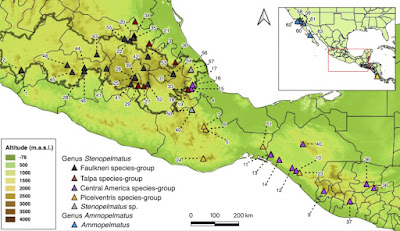 |
| (a) Stenopelmatus sartorianus, Costa Rica, Puntarenas, Monteverde; (b) S. sartorianus, Mexico, Chiapas, El Triunfo; (c) S. sartorianus, Mexico, Veracruz, Fortín de las Flores; (d) S. sp., Guatemala, Chimaltenango, San José Calderas; (e) S. sp., Guatemala, El Progreso, San Agustín de Acasaguastlán; (f) S. sp., Mexico, Michoacán, Pueblo Viejo; (g) S. sp., Mexico, Michoacán, Santuario de la Mariposa Monarca; (h) S. sp., Mexico, Chiapas, Reserva Huitepec; (i) S. sp., Mexico, Michoacán, Pueblo Viejo; (j) S. sp. aff. talpa, Mexico, CDMX, Coyoacán; (k) S. talpa, Mexico, Hidalgo, Jacala; (l) S. typhlops, Mexico, Hidalgo, Zacualtipán. in Gutiérrez-Rodríguez, ... et Vandergast, 2022. DOI: 10.1071/IS21022 |
Abstract
The Jerusalem cricket subfamily Stenopelmatinae is distributed from south-western Canada through the western half of the United States to as far south as Ecuador. Recently, the generic classification of this subfamily was updated to contain two genera, the western North American Ammopelmatus, and the Mexican, and central and northern South American Stenopelmatus. The taxonomy of the latter genus was also revised, with 5, 13 and 14 species being respectively validated, declared as nomen dubium and described as new. Despite this effort, the systematics of Stenopelmatus is still far from complete. Here, we generated sequences of the mitochondrial DNA barcoding locus and performed two distinct DNA sequence-based approaches to assess the species' limits among several populations of Stenopelmatus, with emphasis on populations from central and south-east Mexico. We reconstructed the phylogenetic relationships among representative species of the main clades within the genus using nuclear 3RAD data and carried out a molecular clock analysis to investigate its biogeographic history. The two DNA sequence-based approaches consistently recovered 34 putative species, several of which are apparently undescribed. Our estimates of phylogeny confirmed the recent generic update of Stenopelmatinae and revealed a marked phylogeographic structure within Stenopelmatus. Based on our results, we propose the existence of four species-groups within the genus (the faulkneri, talpa, Central America and piceiventris species-groups). The geographic distribution of these species-groups and our molecular clock estimates are congruent with the geological processes that took place in mountain ranges along central and southern Mexico, particularly since the Neogene. Our study emphasises the necessity to continue performing more taxonomic and phylogenetic studies on Stenopelmatus to clarify its actual species richness and evolutionary history in Mesoamerica.
Jorge Gutiérrez-Rodríguez, Alejandro Zaldívar-Riverón, David B. Weissman and Amy G. Vandergast. 2022. Extensive Species Diversification and Marked Geographic Phylogenetic Structure in the Mesoamerican Genus Stenopelmatus (Orthoptera: Stenopelmatidae: Stenopelmatinae) revealed by Mitochondrial and Nuclear 3RAD Data. Invertebrate Systematics. 36(1); 1-21. DOI: 10.1071/IS21022

